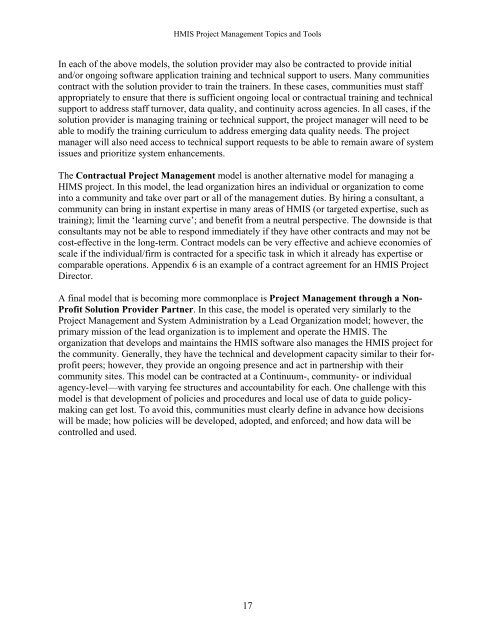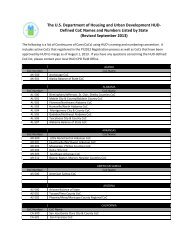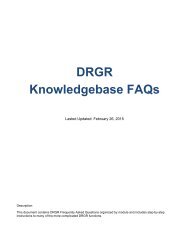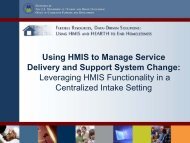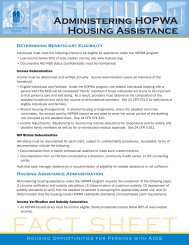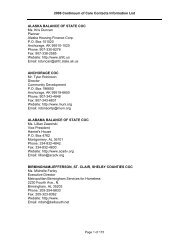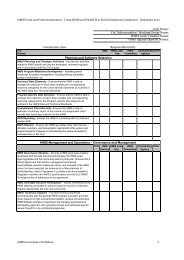HMIS Project Management Topics and Tools - OneCPD
HMIS Project Management Topics and Tools - OneCPD
HMIS Project Management Topics and Tools - OneCPD
- No tags were found...
Create successful ePaper yourself
Turn your PDF publications into a flip-book with our unique Google optimized e-Paper software.
<strong>HMIS</strong> <strong>Project</strong> <strong>Management</strong> <strong>Topics</strong> <strong>and</strong> <strong>Tools</strong>In each of the above models, the solution provider may also be contracted to provide initial<strong>and</strong>/or ongoing software application training <strong>and</strong> technical support to users. Many communitiescontract with the solution provider to train the trainers. In these cases, communities must staffappropriately to ensure that there is sufficient ongoing local or contractual training <strong>and</strong> technicalsupport to address staff turnover, data quality, <strong>and</strong> continuity across agencies. In all cases, if thesolution provider is managing training or technical support, the project manager will need to beable to modify the training curriculum to address emerging data quality needs. The projectmanager will also need access to technical support requests to be able to remain aware of systemissues <strong>and</strong> prioritize system enhancements.The Contractual <strong>Project</strong> <strong>Management</strong> model is another alternative model for managing aHIMS project. In this model, the lead organization hires an individual or organization to comeinto a community <strong>and</strong> take over part or all of the management duties. By hiring a consultant, acommunity can bring in instant expertise in many areas of <strong>HMIS</strong> (or targeted expertise, such astraining); limit the ‘learning curve’; <strong>and</strong> benefit from a neutral perspective. The downside is thatconsultants may not be able to respond immediately if they have other contracts <strong>and</strong> may not becost-effective in the long-term. Contract models can be very effective <strong>and</strong> achieve economies ofscale if the individual/firm is contracted for a specific task in which it already has expertise orcomparable operations. Appendix 6 is an example of a contract agreement for an <strong>HMIS</strong> <strong>Project</strong>Director.A final model that is becoming more commonplace is <strong>Project</strong> <strong>Management</strong> through a Non-Profit Solution Provider Partner. In this case, the model is operated very similarly to the<strong>Project</strong> <strong>Management</strong> <strong>and</strong> System Administration by a Lead Organization model; however, theprimary mission of the lead organization is to implement <strong>and</strong> operate the <strong>HMIS</strong>. Theorganization that develops <strong>and</strong> maintains the <strong>HMIS</strong> software also manages the <strong>HMIS</strong> project forthe community. Generally, they have the technical <strong>and</strong> development capacity similar to their forprofitpeers; however, they provide an ongoing presence <strong>and</strong> act in partnership with theircommunity sites. This model can be contracted at a Continuum-, community- or individualagency-level—with varying fee structures <strong>and</strong> accountability for each. One challenge with thismodel is that development of policies <strong>and</strong> procedures <strong>and</strong> local use of data to guide policymakingcan get lost. To avoid this, communities must clearly define in advance how decisionswill be made; how policies will be developed, adopted, <strong>and</strong> enforced; <strong>and</strong> how data will becontrolled <strong>and</strong> used.17


